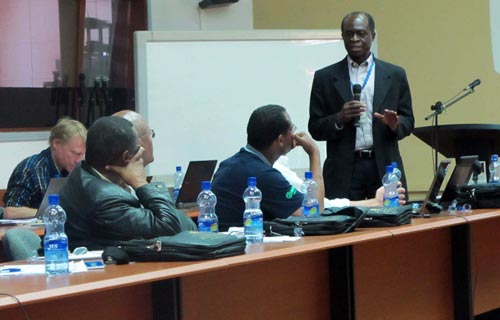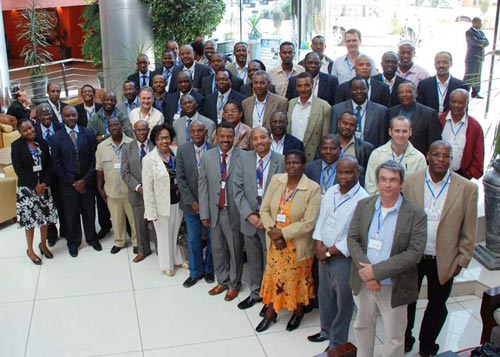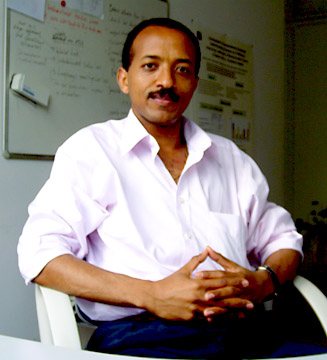NuME set to boost nutrition of Ethiopian children
 During 26-28 March 2012, CIMMYT scientists, partners, and collaborators met in Addis Ababa, Ethiopia, for the Inception Planning Workshop of the NuME project. NuME (Nutritious Maize for Ethiopia) is a new five-year USD 13 million project that aims to significantly reduce malnutrition, especially among young children, and increase food security and household income of resource-poor smallholder farmers in Ethiopia through the widespread adoption, production, and utilization of quality protein maize (QPM). QPM contains more than twice as much lysine and tryptophan as conventional maize, giving its protein a nutritive value that is roughly 90% that of milk.
During 26-28 March 2012, CIMMYT scientists, partners, and collaborators met in Addis Ababa, Ethiopia, for the Inception Planning Workshop of the NuME project. NuME (Nutritious Maize for Ethiopia) is a new five-year USD 13 million project that aims to significantly reduce malnutrition, especially among young children, and increase food security and household income of resource-poor smallholder farmers in Ethiopia through the widespread adoption, production, and utilization of quality protein maize (QPM). QPM contains more than twice as much lysine and tryptophan as conventional maize, giving its protein a nutritive value that is roughly 90% that of milk.
The project, led by CIMMYT and supported by the Canadian International Development Agency (CIDA), is being implemented in collaboration with the Ethiopian Institute of Agricultural Research (EIAR), the Ministry of Agriculture (MoA), the Ministry of Health, the Ethiopian Health and Nutrition Research Institute (EHNRI), Sasakawa Africa Association (SAA), Sasakawa Global 2000 (SG2000), other NGOs, universities, and public and private seed companies. The purpose of the meeting was to present the approved project to partners; review, organize, and agree on the project’s management structure; review and agree on partner roles and responsibilities; and develop detailed work plans and budgets.
Project coordinator S. Twumasi-Afriyie gave an overview of the status of QPM in Ethiopia and pointed out that NuME was building on the achievements of the previous and largely successful CIDA-funded QPMD project that was implemented in Ethiopia, Kenya, Tanzania, and Uganda during 2003-2010.
Underscoring NuME’s importance, Twumasi said that diets in eastern and central Africa are largely based on maize, for it provides up to 80% of the calories consumed and is a primary weaning food for children. However, it is poor in two essential amino acids, lysine and tryptophan, putting infants who consume maize without protein supplements at risk for malnutrition and stunted growth and development. The problem is more acute in Ethiopia, where 47% of children are stunted, 38% are underweight, and 11% suffer from wasting.
Consequently, the project has targeted areas with high maize production and consumption, areas where farmers grow BH660 or other conventional maize varieties that now have QPM versions, and most importantly, areas with high malnutrition, according to Hugo De Groote, CIMMYT socio-economist.
Andreas Oswald, SAA director of crop productivity enhancement, outlined the strategies planned for demonstrating new QPM technologies, improved crop management practices, and post-harvest handling and processing to farmers, and for improving their knowledge and skills. Increasing the participation of women in NuME activities and identifying ways to ensure that they benefit substantively from QPM technologies are key goals of the project.
The project will also partner with Farm Radio International (FRI), which will work with Ethiopian radio stations to develop a gender sensitive campaign to help women and men farmers gain a better understanding of nutrition and protein, and to raise awareness of QPM and other strategies for improving the nutrition and health of families, especially children.
 During 26-27 October 2011, seed policy experts met in Addis Ababa, Ethiopia, for a workshop on “Maize seed sector development in eastern and southern Africa”, to chart the way forward for the regions’ seed systems. The workshop was organized by CIMMYT as part of the Drought Tolerant Maize for Africa (DTMA) project, and brought together permanent secretaries of agriculture ministries, members of parliament, seed companies, seed traders associations, heads of research organizations, scientists, and seed regulators from eight of the project countries (Ethiopia, Kenya, Malawi, Mozambique, Uganda, Tanzania, Zambia, and Zimbabwe).
During 26-27 October 2011, seed policy experts met in Addis Ababa, Ethiopia, for a workshop on “Maize seed sector development in eastern and southern Africa”, to chart the way forward for the regions’ seed systems. The workshop was organized by CIMMYT as part of the Drought Tolerant Maize for Africa (DTMA) project, and brought together permanent secretaries of agriculture ministries, members of parliament, seed companies, seed traders associations, heads of research organizations, scientists, and seed regulators from eight of the project countries (Ethiopia, Kenya, Malawi, Mozambique, Uganda, Tanzania, Zambia, and Zimbabwe). Girma Tesfahun, post doctoral fellow based at CIMMYT’s office in Addis Ababa, was elected president of the Agricultural Economics Society of Ethiopia (AESE) for the next two years. The AESE’s general assembly elected Tesfahun at their 12th annual conference from 14-15 August 2009 in Addis Ababa. The executive committee has five members and includes senior economists from universities, national agricultural research programs, the private sector, and staff from the
Girma Tesfahun, post doctoral fellow based at CIMMYT’s office in Addis Ababa, was elected president of the Agricultural Economics Society of Ethiopia (AESE) for the next two years. The AESE’s general assembly elected Tesfahun at their 12th annual conference from 14-15 August 2009 in Addis Ababa. The executive committee has five members and includes senior economists from universities, national agricultural research programs, the private sector, and staff from the